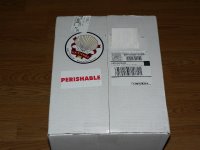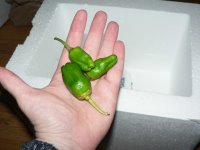 After my last post, I couldn't stop thinking about pimientos. Some google searches turned up a local greenhouse that sells the seeds. Then, I came across tienda.com. They have a grower in Virginia and they ship the peppers once a week. Of course I had to order them. Today, when I arrived home, I found this box.
After my last post, I couldn't stop thinking about pimientos. Some google searches turned up a local greenhouse that sells the seeds. Then, I came across tienda.com. They have a grower in Virginia and they ship the peppers once a week. Of course I had to order them. Today, when I arrived home, I found this box.
When I opened it, I was overwhelmed with a scent that reminded me of a five amazing weeks in Santiago de Compostela, Spain. Almost every day I would meet up with friends and sit at a cafe, sipping sangria and eating pimientos de padron.
How I ended up in Santiago is a very interesting story and I'll share that on a future post. Since I was there on my ow
 n, I was more open and met many people. My subsequent trip to Sweden was to visit with some friends I met while I was in Spain.
n, I was more open and met many people. My subsequent trip to Sweden was to visit with some friends I met while I was in Spain.Before I cooked up some of the peppers, I took this photo. Aren't they cute? These tiny little peppers taste like nothing I have tried here in the states.

I'd never cooked pimientos de padron before, but there were directions printed on container. Basically heat olive oil, add the peppers, saute until they blister and brown. Then sprinkle with ground sea salt. While they were cooking, the house filled with the exquisite aroma that I remember so well. Finally the peppers were done. These are finger food. You hold them by the stem and eat the rest of the pepper.
I only cooked up a few, but they were so good I ended up making a second small batch. Like I mentioned before they are usually sweet/savory; however there are always a few spicy ones mixed in. There were two comfortably spicy peppers in my batches and one that was too spicy to finish.

Pimientos de Padron are native to Santiago de Compostela and Galicia region of Spain which is where I spent my time. Santiago is beautiful city with a rich history. The Camino de Santiago is a trail that leads from the border of France all the way to Santiago which is on Spain's northwestern coast. Pilgrims follow the trail to reach the catherdral in Santiago where legend says St. James is buried. Santiago actually means Saint James. Each of the cathedral's four sides are built using a different styles of architecture. The original cathedral was built during the 1100's and over the years it was expanded. To the right is a photo looking down at the city and cathedral from Monte Pedroso (a mountain on the outskirts of the city).
Inside the church is the world's largest incense burner. I've seen priests swing a small silver incense burner during services in movies or on tv before. I'm not all that familiar with why it is done, but I suspect it originated in Santiago. On special occasions the huge 5 foot tall silver incense burner is swung back and forth across the cathedral. I was told that they originally would swing the incense burner to mask the smell of the pilgrims!

 Here are two more photos. The first is closeup of the cathedral. The second is of the area on the southern side the church which was named by the medieval silversmiths. The area outside is known as Plaza de Platerias. (Plaza of the silversmiths) Many stores on this side of the square sell jewelry. The photo is of fuente de los caballos which means fountain of the horses. I snapped that picture on my first day in Spain.
Here are two more photos. The first is closeup of the cathedral. The second is of the area on the southern side the church which was named by the medieval silversmiths. The area outside is known as Plaza de Platerias. (Plaza of the silversmiths) Many stores on this side of the square sell jewelry. The photo is of fuente de los caballos which means fountain of the horses. I snapped that picture on my first day in Spain.I've got many more photos of Santiago and the surrounding areas and will try to post some in the future. Hope you all have a nice weekend!




4 comments:
Wow, those ARE cute. And what a super cool story, Jody. It will be very interesting to read about your travel... but finding out about Pimientos is also a cool discovery. So thanks for the learning session!!
What great pictures! I'm thinking that Spain is going to have to be the destination for our next vacation.
Very interesting little pepper (with an even more interesting story). Thanks for taking us along on your journey. Your pictures are really beautiful.
You are one of my shout outs today! ;)
Post a Comment